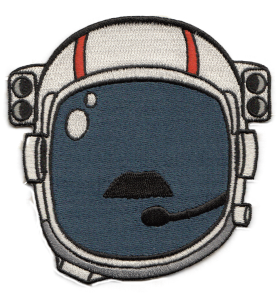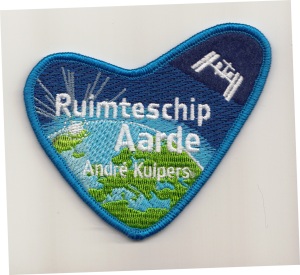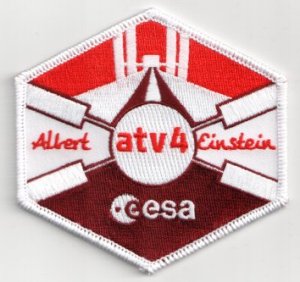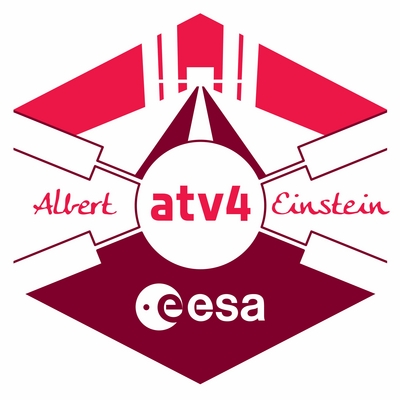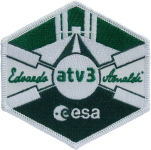Space Helmet Moustache Patch
Astronaut Helmet Moustache Patch – Limited Edition
Limited Edition – Astronaut Helmet Moustache Patch
This limited edition patch (100 only) is the first in a series of space themed collectables that assist good causes too. Recent space station commander Chris Hadfield, sporting a fine moustache, raised the profile of space exploration around the world with his musical abilities and a series of ‘life in space’ videos broadcast from the International Space Station (ISS).
About Movember
Fifty pence from the sale of each patch will be donated to the Movember charity. Find out more about Movember here!
International Space Station Insignia
Large detailed 6″ diameter version of this classic design featuring the completed ISS – International Space Station, circled by the national flags of the international participant countries. Highly detailed will make a great display centerpiece, or great on a jacket.
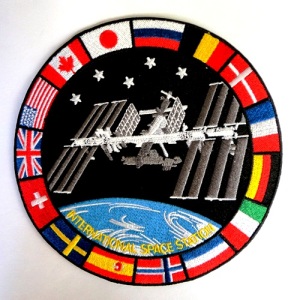 Space Station
Space Station
The International Space Station marked its 10th anniversary of continuous human occupation on Nov. 2, 2010. Since Expedition 1, which launched Oct. 31, 2000, and docked Nov. 2, the space station has been visited by 204 individuals.
At the time of the anniversary, the station’s odometer read more than 1.5 billion statute miles (the equivalent of eight round trips to the Sun), over the course of 57,361 orbits around the Earth.
As of July 2012, there have been 125 launches to the space station since the launch of the first module, Zarya, at 1:40 a.m. EST on Nov. 20, 1998: 81 Russian vehicles, 37 space shuttles, one U.S. commercial vehicle, three European and three Japanese vehicles. The final space shuttle mission July 8-21, 2011, by Atlantis delivered 4.5 tons of supplies in the Raffaello logistics module.
A total of 162 spacewalks have been conducted in support of space station assembly totaling more than 1,021 hours.
The space station, including its large solar arrays, spans the area of a U.S. football field, including the end zones, and weighs 861,804 pounds, not including visiting vehicles. The complex now has more livable room than a conventional five-bedroom house, and has two bathrooms, a gymnasium and a 360-degree bay window.
Additional launches will continue to augment these facts and figures, so check back here for the latest.
International Space Station Size & Mass
- Module Length: 167.3 feet (51 meters)
- Truss Length: 357.5 feet (109 meters)
- Solar Array Length: 239.4 feet (73 meters)
- Mass: 924,739 pounds (419,455 kilograms)
- Habitable Volume: 13,696 cubic feet (388 cubic meters)
- Pressurized Volume: 32,333 cubic feet (916 cubic meters)
- Power Generation: 8 solar arrays = 84 kilowatts
- Lines of Computer Code: approximately 2.3 million
Looking back – ISS Crew Patches
Crew patches
![]()
![]()
Each resident International Space Station crew has their own crew patch. The patch adorns the crew’s clothing, spacesuits and other crew items.
The patch designs are often full of symbolic references. So too are the patches designed for Expedition 20 and 21 – the two ISS crews that Frank De Winne will be a part of during his six-month mission.
The Expedition 20 and 21 patches are shown below, together with an explanation of their design.
 |
| ISS Expedition 20 crew patch |
The ISS Expedition 20 crew patch symbolizes a new era in space exploration with the first six-person crew living and working on the ISS and represents the significance of the ISS to the exploration goals of NASA and its international partners.
The six gold stars signify the men and women of the crew. The astronaut symbol extends from the base of the patch to the star at the top to represent the international team, both on the ground and on orbit, that are working together to further our knowledge of living and working in space.
The space station in the foreground represents where we are now and the important role it is playing towards meeting our exploration goals. The knowledge and expertise developed from these advancements will enable us to once again leave low earth orbit for the new challenges of establishing a permanent presence on the moon and then on to Mars.
The blue, gray and red arcs represent our exploration goals as symbols of Earth, the Moon and Mars.
 |
| ISS Expedition 21 crew patch |
The central element of the ISS Expedition 21 crew patch is inspired by a fractal of six, symbolizing the teamwork of the six-person crew. From the basic element of one person, together six people form a much more complex and multifaceted entity, toward the infinity of the universe.
The patch shows children, on Earth in the bright Sun, as our future and the reason we explore. The Soyuz and Shuttle are the vehicles that enable human space exploration today, while the International Space Station is leading to our next goals, the moon and Mars.
The patch shape has six tips, geometrically sound yet reminiscent of a leaf, representing symmetry and ecological harmony, while the six stars in deep space represent the current crew and future exploration crews.
 |
| Soyuz TMA-15 crew patch |
Above is the crew patch that was worn by Russian cosmonaut Roman Romanenko, ESA astronaut Frank De Winne and Canadian Space Agency astronaut Robert Thirsk for their flight to the International Space Station with the Soyuz TMA-15 spacecraft.
An angel, painted by Yura Menkevich (aged 15) of the Kemerovo region in West Siberia, Russia, was chosen as the central element for the Soyuz TMA-15 patch.
Official André Kuipers ‘Spaceship Earth’ Embroidered Patch
 |
|
During his stay in orbit, André Kuipers will have a unique view of ‘Spaceship Earth’ from his very own spaceship, the International Space Station. From the spectacular vantage point provided by Cupola, the ESA astronaut will have the opportunity to observe both the beauty and fragility of our planet.
His observations will support the ESA online lessons designed to help European children strengthen their knowledge in science, technology, engineering and mathematics. These will be part of three themes covering topics such as Life in Space, Biodiversity on Earth and planet Earth’s climate.
As part of Spaceship Earth, André will perform experiments on board which can also be carried out by schools. ESA is providing school kits with replicas of the experiments on board the ISS.
Lessons associated with Spaceschip Earth will be released throughout the PromISSe mission.
 |
Theme 1: Life
Radiation
Radiation is the term used for all phenomena characterised by the transport of energy, either by waves or sub-atomic particles. This lesson for secondary school students (16-18), explains different types of radiations and how some forms of radiation pose a threat to astronauts.
Balance in Space
Keeping balance on Earth is relatively easy because gravity dictates how the vestibular apparatuses behave in the inner ears. In conditions of microgravity such as on the ISS, astronauts can be very easily disoriented. This lesson for lower secondary school children (12-14) demonstrates how balance can also be affected by visual cues and incorporates a fun practical activity.
Immunology
Understanding how the immune system functions will eventually lead to answers about many diseases including cancers. This lesson, intended for upper secondary school students (14-17), explains the basics of the immune system but also discusses the fact that astronauts in Space, for various reasons, have depressed immune responses. This is particularly important to study if humans are to live in microgravity for extended periods of time
Life Support Systems
We now have the capability to leave planet Earth. However, if man is to live in space and travel to other planets, we must learn how to survive out there for longer periods of time; we have to recreate in space the vital ingredients for life on Earth.
On the International Space Station many of Earth’s environmental support systems have already been engineered. Examining how some of these key technologies work, allows us to understand the vital ingredients that make Earth such an ideal place to live.
In the DVD ‘Ingredients for Life: On Earth and in Space’, aimed primarily at 16-18 year old students, we explore how ESA is dealing with these scientific and technological challenges, and we answer questions like: Why do we need water and oxygen? How do astronauts get the oxygen they need to survive in space?
 |
Theme 2: Biodiversity
Convection
Convection depends on gravity: as liquids and gases heat up they become less dense and lighter. When they cool again, they become denser and fall towards Earth. These processes can be observed in large scale on Earth but also in the small convection loops provided in the ESA EPO kits. Ocean currents and atmospheric movement due to warmth from the Sun determines where life on Earth flourishes and where life struggles. Biodiverse regions on Earth are largely dependent on convection.
Official André Kuipers ‘Spaceship Earth’ Embroidered Patch
(Dutch Language version)
ESA ATV-4 Automated Transfer Vehicle Official Embroidered Patch
ESA ATV-4 Automated Transfer Vehicle Official Embroidered Patch
Patch measures approx 90mm x 90mm
Official ATV-4 now available, ATV-4 could only be released following the successful launch of ATV-3.
ATV-4 to carry name Albert Einstein
 |
|
| |
With ATV Johannes Kepler in space and ATV Edoardo Amaldi almost built, the next Space Station supply craft coming off the production line has been named after the most famous scientist of all time: Albert Einstein. Launch is expected in early 2013.
With relativity and E=mc2, Albert Einstein is a major icon of 20th century science.
His theories have been stringently tested in space and his work is used to guide spacecraft to other planets – and now he will fly into orbit. ESA has decided to name the fourth Automated Transfer Vehicle (ATV) after Albert Einstein.
 |
|
| ATV-2 docking with ISS on 24 February 2011 |
ATVs are an essential contribution by Europe for supplying and maintaining the International Space Station.
The vessels are named after great European scientists and visionaries to highlight Europe’s deep roots in science, technology and culture.
Naming ATV-4 after Albert Einstein, as proposed by the Swiss delegation to ESA, reflects this approach. Einstein’s contributions to humanity and, in particular, science overturned our perception of the Universe.
ATV is also strongly linked to Switzerland: its structure is built by Swiss industry.
 |
|
| |
World citizen with roots in Switzerland
Albert Einstein was born in 1879 in Ulm, in Germany, but studied and spent his early career in Switzerland.
His job at the patent office in Bern gave him time to develop his revolutionary ideas. His annus mirabilisof 1905 – year of wonder – saw him publish four fundamental scientific papers on the photoelectric effect, Brownian motion, special relativity and the equivalence of matter and energy.
In 1908 he moved to an academic career in Bern and went on to Zurich, Prague, Berlin and, finally, after emigration to the USA before World War II, Princeton University.
He was awarded the Nobel Prize for Physics in 1921. He died in the USA in 1955 at the age of 76.
Next two ATVs on production line
 |
| Pressurised module for Albert Einstein |
After launching ATV Johannes Kepler to the Space Station this February, ESA plans to maintain a steady cadence of one vessel per year.
The next, Edoardo Amaldi, is already assembled and is being tested in Bremen, Germany. ATV-3 will be shipped to Europe’s Spaceport in Kourou, French Guiana, in August for dispatch to the Station in February 2012.
 |
|
| Equipped External Bay of the ATV-4 |
The three main parts of ATV-4 are being built. The Integrated Cargo Carrier, designed to carry water, gas, refuelling propellants and dry cargo, is in Turin, Italy, and will be shipped in December to Bremen.
The Equipped Propulsion Bay, housing the engines and propellant tanks, is built in Bremen.
The Equipped Avionics Bay – ATV’s ‘brain’ – will be mated at end of the year with the propulsion section.
The plan is to launch Albert Einstein to the Station at the beginning of 2013.
ESA ATV-3 Automated Transfer Vehicle Official Embroidered Patch
ESA ATV-3 Automated Transfer Vehicle Official Embroidered Patch
Patch measures approx 90mm x 90mm
Official ATV-3 patch now available, ATV-4 could only be released following successful launch of ATV-3, please see next post.
 |
| ATV-3’s cargo carrier |
3 March 2010
The third ATV, to be launched to the ISS in early 2012, is named after famous Italian physicist and spaceflight pioneer Edoardo Amaldi.
The Italian space agency, ASI, proposed naming ATV-3 after the Italian physicist Edoardo Amaldi (5 September 1908 – 5 December 1989).
“He started working in nuclear physics with Enrico Fermi, did pioneering work in the field of cosmic rays and in the new field of particle physics, becoming an Italian reference character in nuclear science,” said Enrico Saggese, President of ASI.
“Amaldi was one of the few who in the post-war years prompted action ultimately leading to the founding of ESRO, and later ESA.”
 |
|
| Edoardo Amaldi, 1908-1989 |
Father of Italian space research
Edoardo Amaldi was a leading figure in Italian science in the 20th century, particularly in fundamental experimental physics.
In Rome, in the 1930s, Amaldi was a member of a group of young Italian scientists: the Via Panisperna boys (‘I ragazzi di Via Panisperna’), who, led by Enrico Fermi, made the famous discovery of slow neutrons, which later made possible the nuclear reactor.
He contributed to nuclear physics in the 1930s and 1940s and to cosmic rays and particle physics afterwards.
At the beginning of the 1950s, Amaldi was one of the founding fathers of the European Organisation for Nuclear Research (CERN) and from 1952 to 1954 he was Secretary General of CERN’s provisional organisation.
He then became a pioneer in the experimental search for gravitational waves in the 1970s.
It is largely thanks to his drive that Italian physics emerged from the slump following the Second World War.
Amaldi’s concern for peace, and his strong feeling for the responsible role that the scientific community should play in this respect, was always a natural complement to his unshakable belief in the open nature of science and the need for international cooperation.
 |
|
| ATV-3’s avionics bay being delivered |
“Italy is a key European country in our participation to the International Space Station partnership. By naming the ATV-3 after Edoardo Amaldi we celebrate a great Italian, but also a committed European who understood the importance of pooling resources and minds together to achieve important results,” said Simonetta Di Pippo, ESA Director for Human Spaceflight.
“We are paying tribute to a visionary mind, to a great scientist but also to an idea of cooperation that is also embodied in the International Space Station partnership.”
“The ATV is the first recurring production of an exploration spacecraft and places Europe a step closer to our partners. I am glad that Italy is taking so much pride in their participation in the ISS which is a recognition of their human and industrial capabilities.”
Space Station Expedition 3 Insignia
The Expedition Three crew members–astronaut Frank L. Culbertson, Jr., commander, and cosmonauts Vladimir N. Dezhurov and Mikhail Tyurin, flight engineers–had the following to say about the insignia for their scheduled mission aboard the International Space Station (ISS): “The book of space history turns from the chapter written onboard the Russian Mir Station and the U.S. Space Shuttle to the next new chapter, one that will be written on the blank pages of the future by space explorers working for the benefit of the entire world. The space walker signifies the human element of this endeavor. The star representing the members of the third expedition, and the entire multi-national Space Station building team, streaks into the dawning era of cooperative space exploration, represented by the image of the International Space Station as it nears completion.”
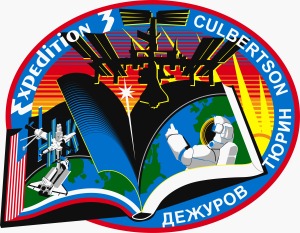
Expedition 3 Mission Patch Available from the Spaceboosters Online Store
International Space Station Expedition 2
The International Space Station Expedition Two patch depicts the Space Station as it appears during the time the second crew will be on board. The Station flying over the Earth represents the overall reason for having a space station: to benefit the world through scientific research and international cooperation in space. The number 2 is for the second expedition and is enclosed in the Cyrillic MKS and Latin ISS which are the respective Russian and English abbreviations for the International Space Station. The United States and Russian flags show the nationalities of the crew indicating the joint nature of the program. When asked about the stars in the background, a crew spokesman said they “…represent the thousands of space workers throughout the ISS partnership who have contributed to the successful construction of our International Space Station.”
Space Station Expeditions – Expedition 1
The first International Space Station crew patch is a simplified graphic of the station complex when fully completed. The station is seen with solar arrays turned forward. The last names of the Expedition One crew, Soyuz pilot Yuri Gidzenko, flight engineer Sergei Krikalev, and expedition commander William (Bill) Shepherd, appear under the station symbol.
ISS Expedition 34 Embroidered Patch Design
Crew: Kevin Ford, Oleg Novitskiy, Evgeny Tarelkin
Launch: October 2012
Landing: March 2013
Soyuz TMA-07M
Crew: Chris Hadfield, Tom Marshburn, Roman Romanenko
Launch: November 2012
Landing: May 2013
-
Recent
- China Spaceflight – Shenzhou 10 Embroidered Mission Patch
- Space Helmet Moustache Patch
- Shenzhou 9 Embroidered Mission Patch
- International Space Station Insignia
- Space Shuttle Orbiter Flag Patches including Enterprise,Columbia,Challenger,Endeavour,Discovery & Atlantis
- Looking back – ISS Crew Patches
- Official André Kuipers ‘Spaceship Earth’ Embroidered Patch
- NASA Commercial Crew Pin (CCP)
- ESA ATV-4 Automated Transfer Vehicle Official Embroidered Patch
- ESA ATV-3 Automated Transfer Vehicle Official Embroidered Patch
- ESA National Flags Patch
- Space Station Expedition 3 Insignia
-
Links
-
Archives
- April 2014 (1)
- November 2013 (1)
- October 2012 (3)
- August 2012 (1)
- July 2012 (1)
- March 2012 (3)
- January 2012 (4)
- December 2011 (1)
- November 2011 (1)
- October 2011 (5)
- September 2011 (3)
- July 2011 (3)
-
Categories
-
RSS
Entries RSS
Comments RSS
